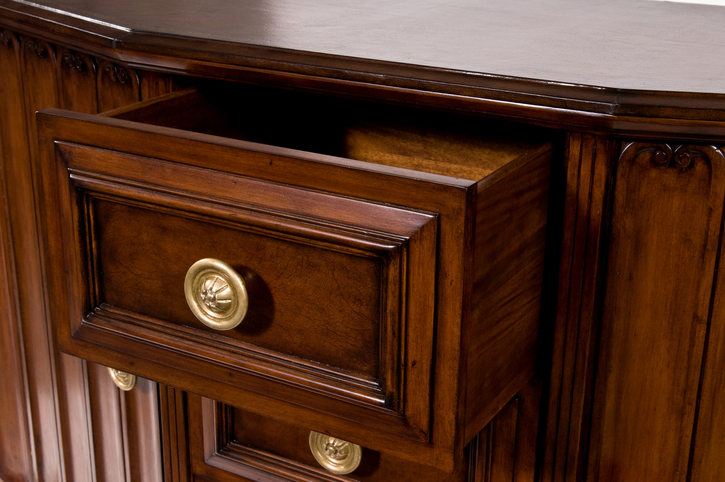- Home
- Learn About Antique Furniture and Reproductions
- Resources
- Mahogany Furniture History
Mahogany Furniture History

The mahogany tree, which includes several related tropical hardwood species, was discovered in the North Americas and the Caribbean in the 17th Century. It is particularly indigenous to Florida, Jamaica, Cuba, the Bahamas, and a majority of Central America. The first applications of the wood were found in carvings by indigenous tribes, who primarily used it to make ceremonial stools and canoes by carving out the tree's massive trunks. After being discovered by European colonists in the mid-1600s, mahogany wood was primarily used in shipbuilding. The tree was discovered to have marked strength and density, so it was a prime building material at the time.
It's unknown exactly where the name 'Mahogany' came from, and it's possible the word was used by indigenous tribes to describe the native trees in their region. Another theory is that the African slaves brought over to the colonies by European explorers identified the tree as being similar to one they knew from their homeland. West Africans from the Yoruba and Ibo people used the word "m'oganwo" to describe the native Khaya trees found in those regions. We now know that the African Khaya tree species is very similar to that of American and Caribbean mahogany trees, which would explain the correlation.
The Export of Mahogany to Europe
The first record of mahogany wood being exported to Europe was in 1702. It wasn't an intentional choice, however, since the export was via a Spanish ship captured and looted by the British Navy. A small amount of mahogany was found in the ship's stores and was brought back to England to be sold. Once it was discovered that the wood's swirling grains and rich hues were ideal for producing certain aesthetic effects, British merchants began seeking mahogany wood for export. Most of these exports originated from Jamaica by way of the American Colonies.
Shortly thereafter, natural mahogany sources began to be harvested in earnest all over the Caribbean and Central America. Since the demand for the wood was growing exponentially in Europe, demand for its export also grew. The competition between merchants and loggers alike to find and capitalize on mahogany forests grew in intensity, which led to the overharvesting and depletion of many of these natural resources. There then began a major effort to seek and find new mahogany sources to keep the wood supplies flush. The rising demand and decreasing supply of mahogany wood added to the apparent value of the material, which assisted in keeping the material costs high.
Mahogany's Rise in Popularity
Before the chance occurrence of mahogany arrived in England in 1702, most fine furniture was constructed out of local wood species like oak, walnut, and yew. But when the aesthetic properties of mahogany were discovered in the 1730s, noble fads and fashion took the reigns. It became the sudden desire of every high-born household to have furniture made out of this beautiful and exotic wood. Mahogany became known as a high-status luxury commodity and a household staple in the majority of Europe. Since status was dictated both by position and material possessions, families would have been considered inferior if they didn't have at least a few pieces of fine mahogany furniture.
One of the greatest driving factors in the rising popularity of mahogany in Europe, and in England especially, was the fact that an Act of Parliament in 1721 (The Naval Stores Act, George I) removed all duties or taxes from timber imported from the American Colonies. This made the price of mahogany comparable to other high-quality timber at the time, which meant it was more accessible to the lower-class nobility as well as royalty. This also increased the import demand from the colonies, making a once-rare material available to many more buyers.
The Lasting Value of Mahogany
Wealthy families highly valued mahogany for its beautiful grains and rich colors, but it was especially valued by British cabinetmakers and joiners for its strength and density. The wood was less prone to warping over time, drastically expanding the furniture's lifespan. So, they knew that the fine pieces they produced would most likely become family heirlooms, which allowed the sale at a higher premium. And because of the wood's strength, the furniture's legs and rails could be made much thinner and with more filagree than typical furniture at the time. These factors led directly to the birth of what we now know as the Chippendale furniture style, with its delicate swirls and thin curved accents.
Because of the explosive popularity of mahogany for aesthetic purposes and the long-lasting quality of the wood, thousands of fine pieces from the 1700s and 1800s still exist today. They're either featured in historical homes and palaces, or they are being bought and sold as high-value antique pieces. But because of this rich history, we know that mahogany will live on as a symbol of wealth and excellent taste.









